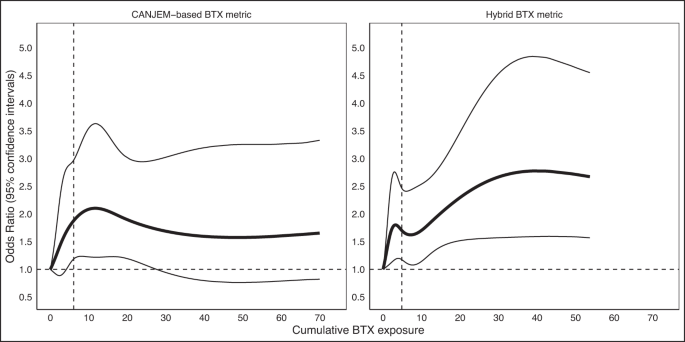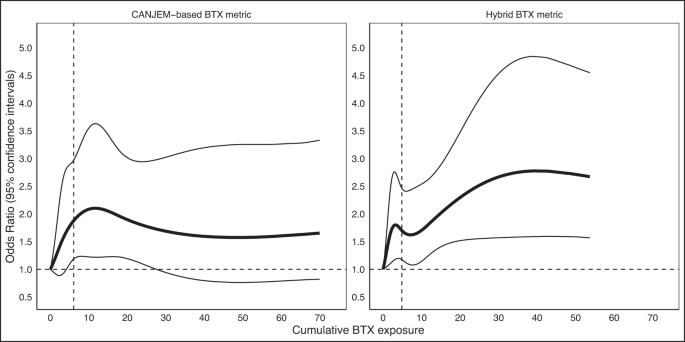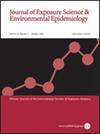Occupational exposure to organic solvents and risk of bladder cancer
IF 4.1
3区 医学
Q2 ENVIRONMENTAL SCIENCES
Journal of Exposure Science and Environmental Epidemiology
Pub Date : 2024-02-16
DOI:10.1038/s41370-024-00651-4
引用次数: 0
Abstract
Bladder cancer has been linked to several occupations that involve the use of solvents, including those used in the dry-cleaning industry. We evaluated exposure to solvents and risk of bladder cancer in 1182 incident cases and 1408 controls from a population-based study. Exposure to solvents was quantitatively assessed using a job-exposure matrix (CANJEM). Exposure to benzene, toluene and xylene often co-occur. Therefore, we created two additional sets of metrics for combined benzene, toluene and xylene (BTX) exposure: (1) CANJEM-based BTX metrics and (2) hybrid BTX metrics, using an approach that integrates the CANJEM-based BTX metrics together with lifetime occupational histories and exposure-oriented modules that captured within-job, respondent-specific details about tasks and chemicals. Adjusted odds ratios (ORs) and 95% confidence intervals (95% CI) were estimated using logistic regression. Bladder cancer risks were increased among those ever exposed to benzene (OR = 1.63, 95% CI: 1.14–2.32), toluene (OR = 1.60, 95% CI: 1.06–2.43), and xylene (OR = 1.67, 95% CI: 1.13–2.48) individually. We further observed a statistically significant exposure-response relationship for cumulative BTX exposure, with a stronger association using the hybrid BTX metrics (ORQ1vsUnexposed = 1.26, 95% CI: 0.83–1.90; ORQ2vsUnexposed = 1.52, 95% CI: 1.00–2.31; ORQ3vsUnexposed = 1.88, 95% CI: 1.24–2.85; and ORQ4vsUnexposed = 2.23, 95% CI: 1.35–3.69) (p-trend=0.001) than using CANJEM-based metrics (p-trend=0.02). There is limited evidence about the role of exposure to specific organic solvents, alone or in combination on the risk of developing bladder cancer. In this study, workers with increasing exposure to benzene, toluene, and xylene as a group (BTX) had a statistically significant exposure-response relationship with bladder cancer. Future evaluation of the carcinogenicity of BTX and other organic solvents, particularly concurrent exposure, on bladder cancer development is needed.


职业接触有机溶剂与膀胱癌风险。
背景:膀胱癌与多种涉及使用溶剂的职业有关:膀胱癌与几种涉及使用溶剂的职业有关,包括干洗业中使用的溶剂:我们对一项基于人群的研究中的 1182 例发病病例和 1408 例对照病例进行了溶剂暴露和膀胱癌风险评估:方法:使用工作暴露矩阵(CANJEM)对溶剂暴露进行定量评估。苯、甲苯和二甲苯的暴露往往同时存在。因此,我们为苯、甲苯和二甲苯(BTX)的联合暴露创建了两套额外的指标:(1)基于 CANJEM 的 BTX 指标;(2)混合 BTX 指标,使用的方法是将基于 CANJEM 的 BTX 指标与终生职业史和以暴露为导向的模块整合在一起,这些模块捕捉了工作内部、受访者特定的任务和化学品细节。采用逻辑回归法估算了调整后的几率比(OR)和 95% 置信区间(95% CI):结果:曾经接触过苯(OR = 1.63,95% CI:1.14-2.32)、甲苯(OR = 1.60,95% CI:1.06-2.43)和二甲苯(OR = 1.67,95% CI:1.13-2.48)的人患膀胱癌的风险增加。我们进一步观察到,累积 BTX 暴露在统计学上具有显著的暴露-反应关系,使用混合 BTX 指标则具有更强的关联性(ORQ1vsUnexposed = 1.26,95% CI:0.83-1.90;ORQ2vsUnexposed = 1.26,95% CI:0.83-1.90)。90;ORQ2vsUnexposed = 1.52,95% CI:1.00-2.31;ORQ3vsUnexposed = 1.88,95% CI:1.24-2.85;ORQ4vsUnexposed = 2.23,95% CI:1.35-3.69)(p-趋势=0.001)比使用基于 CANJEM 的指标(p-趋势=0.02)更强:关于接触特定有机溶剂(单独或混合接触)对罹患膀胱癌风险的影响,目前证据有限。在这项研究中,接触苯、甲苯和二甲苯的工人作为一个群体(BTX),与膀胱癌的接触-反应关系在统计学上有显著意义。今后需要对 BTX 和其他有机溶剂的致癌性进行评估,特别是同时接触这些有机溶剂对膀胱癌发病的影响。
本文章由计算机程序翻译,如有差异,请以英文原文为准。
求助全文
约1分钟内获得全文
求助全文
来源期刊
CiteScore
8.90
自引率
6.70%
发文量
93
审稿时长
3 months
期刊介绍:
Journal of Exposure Science and Environmental Epidemiology (JESEE) aims to be the premier and authoritative source of information on advances in exposure science for professionals in a wide range of environmental and public health disciplines.
JESEE publishes original peer-reviewed research presenting significant advances in exposure science and exposure analysis, including development and application of the latest technologies for measuring exposures, and innovative computational approaches for translating novel data streams to characterize and predict exposures. The types of papers published in the research section of JESEE are original research articles, translation studies, and correspondence. Reported results should further understanding of the relationship between environmental exposure and human health, describe evaluated novel exposure science tools, or demonstrate potential of exposure science to enable decisions and actions that promote and protect human health.

 求助内容:
求助内容: 应助结果提醒方式:
应助结果提醒方式:


